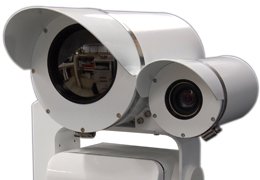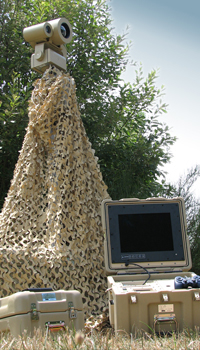
In today’s heightened security environment, around the clock intrusion detection is imperative. Thermal imaging solutions answer the call twenty-four hours a day in any weather condition. Because thermal imaging detects energy emitted from all objects without the need of visible light, intruders can be unveiled day or night, through smoke, fog, sand, rain, and snow. These camera systems attach to your network using a built-in Camera Encoder Server, making it very easy to deploy, control and operate.
Thermal Camera Features:
- These thermal imagers are long wavelength (8-12 micron), infrared video cameras intended for use in all weather applications.
- Visible color day/night cameras are repeatedly rendered ineffective by low contrast lighting or blooming bright light conditions; however, Kintronics Thermal Imaging Systems provide unhindered, real-time scene playback of any security scenario.
- All imagers utilize uncooled technology to produce high-quality imagery for high-security applications. This type of thermal imager will detect thermal activity in total darkness, through smoke, dust, blowing sand, fog, and other obscurants.
These thermal Imaging Systems integrate easily into all site security solutions. We offer several different system controllers, including the more popular protocols. The open architecture makes it easy to integrate customizes protocols to meet individual needs.
Models Available
The thermal camera systems are custom configured to your exact requirements. Models include short, medium and long-range systems. All these models are available with network connections so they can be integrated with other IP cameras.
| Model |
Description |
|---|---|
| EXSRTI18PTH | Attaches to your Network providing 1220 meters upright man recognition or 2440 meters vehicle recognition. |
| MRT1-EX9PT-VIS | 2000 meters man recognition with color day-night camera. |
| MRT1 | 750-meter man recognition |
| LRT1-m15/5-DD-VIS31 | 2000 meters man recognition, Wireless Deploy Control platform, VIS/312 Color CCD option |
| TVIP-PHX-640-30X-100HD | Thermal 640 x 480 camera with 100 mm thermal fixed lens, plus Optical 2 Megapixel PTZ camera. The thermal camera provides human detection at night up to 1.8 miles (2.9 Km), Optical daytime detection at up to 3.7 miles ( 5.9 Km) |
| LRT145PTZ2CIF | Long Range Thermal Imager with 320×240 lines of resolution. Includes IP network connection and PTZ capability. |
Dual Sensor Cameras
Custom made long-range night-vision cameras are available. These cameras can be selected with both thermal and optical cameras. Models can also be selected with adaptive IR illumination. Take a look at our long-range night-vision camera systems.
Applications include:
- Military Bases
- Government Installations
- Power Plants
- Airports
- Shipping Ports
- Border Security
- Refineries
- Infrastructure
- Mobile Surveillance
Contact us for more details about all the models available. We have military grade and commercial grade thermal imaging cameras available.

These Mil-Spec 810-F thermal imagers are available with 52 degree to 3 degree field of view. They can be mounted stand alone, paired with IR visual cameras or combined with a variety of positioners.
High performance optical IP cameras can be provided alongside the long-range thermal system, creating a very flexible system that operates day or night and in any weather.
Network attached IP cameras are very easy to deploy. They include H.264 compression and are compatible with our IP Video Recording Systems.
Technical Background
The difference between an IP optical camera and a Thermal Imaging camera
An optical IP camera with an IR illuminator projects light on a target, while thermal cameras use the thermal radiation from the source. The illuminator used with an IP camera uses “near” IR wavelengths 0.70–1.0 µm (700 nm – 1000 nm) to “illuminate” a dark scene. There are 850 nm (0.85 µm) and 940 nm (0.94 µm) IR illuminators available. The 850 nm versions are visible to the eye, while the 950 nm are invisible.
The thermal imaging camera uses the longer wavelength spectrum (8–15 µm). This thermal energy spectrum is actually emanating from the source (a warm body), rather than being “illuminated”. Standard IR illuminators have a range of up to 200 m, while laser IR illuminators have a range of up to 5000 m. Thermal cameras provide a much larger field of view, allowing you to detect a target in a much larger area. These can see through weather related obscurants or smoke, while IR illuminators can’t. Optical cameras with IR illuminators can provide more detail, allowing you to identify a person’s face at over 1 mile away (1.6 km). Take a look at our article for more information about Detection, Recognition, and Identification – Thermal vs. Optical IP Camera. There are cameras available that include both thermal and optical sensors, providing a very effective detection and recognition long range camera system.
FLIR
Thermal cameras were originally called forward-looking infrared devices by the airforce. The F.L.I.R. acronym was generated by our US military when this technology was first utilized. Some of the first thermal imagers were mounted on the front of reconnaissance aircraft, hence the name forward-looking infrared or FLIR.
How Thermal Imagers Work
Thermal cameras have imaging devices that detect emitted infrared wavelengths. Simply put, all objects that are above absolute 0º constitute molecular movement. This molecular movement produces energy or “heat.” The heat is emitted not in the visible spectrum but in the infrared spectrum, which is invisible to the human eye. Thermal imagers detect this emitted infrared energy and process the information electronically into a video or “visual” image so that we can “see” the emitted energy. Thermal imagers allow us to see objects in total darkness, see heat signatures left by hand or footprints and many other scenarios that we would not be able to normally “see” in the visual world.